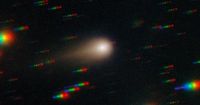Stargazers and scientists alike are turning their eyes toward an extraordinary visitor: comet 3I/ATLAS, an interstellar object currently making a brief, spectacular pass through our solar system. Discovered on July 1, 2025, by the ATLAS (Asteroid Terrestrial-impact Last Alert System), this comet is only the third known interstellar object to be detected within our cosmic neighborhood, following the enigmatic 'Oumuamua in 2017 and 2I/Borisov in 2019, according to Space.com and The Economic Times.
On August 27, 2025, the Gemini South telescope, perched atop Cerro Pachón in Chile, captured the most detailed images yet of 3I/ATLAS. These images, taken during a public outreach event that allowed students to remotely join astronomers in the control room, reveal a comet with a dramatically growing tail and a wide coma of dust and gas enveloping its icy nucleus. As AP reported, the tail is now significantly more extended than in previous observations—a sign that 3I/ATLAS is becoming more active as it speeds toward the Sun.
At the time of this imaging, the comet was about 277 million miles from Earth, with its closest approach to our planet still months away. NASA has confirmed that 3I/ATLAS poses no threat to Earth; its closest passage will occur in December 2025 at a distance of 167 million miles—well beyond the orbit of the Sun from our perspective.
The Gemini South images are more than just visually stunning. They provide a treasure trove of scientific data. The comet’s tail, stretching up to 1/120th of a degree in the sky (for reference, one degree is roughly the width of your pinky finger at arm’s length), is a direct result of solar radiation heating the comet’s ices. This process, called sublimation, causes the solid ice to turn directly into gas, which then erupts from the comet and forms both the coma and the tail. As 3I/ATLAS draws nearer to the Sun, these features have become more pronounced, a phenomenon that astronomers anticipated and are now witnessing in real time.
"As 3I/ATLAS speeds back into the depths of interstellar space, this image is both a scientific milestone and a source of wonder," said Karen Meech, an astronomer at the University of Hawaii Institute for Astronomy and leader of the observation program, in a statement quoted by Space.com. "It reminds us that our solar system is just one part of a vast and dynamic galaxy—and that even the most fleeting visitors can leave a lasting impact."
3I/ATLAS’s journey is being chronicled by a suite of world-class observatories. In July, the Hubble Space Telescope captured high-resolution images that helped narrow estimates of the comet’s nucleus size and revealed fine details near its head. The James Webb Space Telescope (JWST) has also joined the campaign, using its infrared instruments to analyze the faint heat signatures and gases released by the comet. By combining the wide-field perspective of Gemini South with the sharp imaging of Hubble and the infrared prowess of JWST, astronomers are assembling the most complete portrait yet of an interstellar comet.
But what makes 3I/ATLAS truly remarkable isn’t just its origin from another star system or its spectacular tail. It’s what this visitor can tell us about the broader cosmos. According to Space.com, spectral analysis of the light emitted by the comet’s coma and tail indicates that its chemical composition is strikingly similar to that of comets formed within our own solar system. This finding suggests that the processes that shaped our Sun’s planetary system some 4.6 billion years ago may be common throughout the galaxy—a tantalizing hint that planetary formation follows similar rules, whether here or around another star.
"The primary objectives of the observations were to look at the colors of the comet, which provide clues to the composition and sizes of the dust particles in the coma, and to take spectra for a direct measure of the chemistry," Meech explained. "We were excited to see the growth of the tail, suggesting a change in the particles from the previous Gemini images, and we got our first glimpse of the chemistry from the spectrum."
This rare opportunity to study material from another planetary system has not been lost on the scientific community. As Bryce Bolin, a research scientist from Eureka Scientific who assisted with the observations, noted, "Every interstellar comet is a messenger from another star system, and by studying their light and color, we can begin to understand the diversity of worlds beyond our own."
The public has also played a role in this cosmic investigation. The images were collected in collaboration with the Shadow the Scientists initiative, which connects researchers with the general public as they perform authentic scientific experiments. During the Gemini South observing session, students and members of the public were able to work alongside astronomers, witnessing firsthand the process of capturing and analyzing data from a once-in-a-lifetime visitor.
Looking ahead, 3I/ATLAS will make its closest approach to the Sun—its perihelion—on October 30, 2025, at about 1.4 astronomical units (roughly 130 million miles) from the Sun, according to DIY Photography. After passing between the orbits of Mars and Earth, the comet will swing back out into the depths of interstellar space, likely never to return. It will remain visible to telescopes through September before becoming unobservable as it disappears behind the Sun, reemerging in December for a final round of observations before fading from view.
While 3I/ATLAS will never become bright enough to be seen with the naked eye, its scientific value is immense. Each observation adds a new piece to the puzzle of how stars, planets, and comets form across the galaxy. As astronomers continue to monitor its activity, they hope to glean even more insights into the building blocks of distant worlds—and, perhaps, our own cosmic origins.
For now, 3I/ATLAS serves as a vivid reminder of our place in a vast universe. Even the briefest visitors can teach us profound lessons, and the fleeting tail of an interstellar comet can illuminate mysteries that stretch across the stars.





